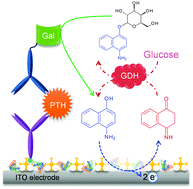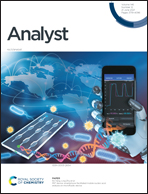Sensitive electrochemical immunosensor using a bienzymatic system consisting of β-galactosidase and glucose dehydrogenase†
Abstract
Bienzymatic systems are often used with electrochemical affinity biosensors to achieve high signal levels and/or low background levels. It is important to select two enzymes whose reactions do not exhibit mutual interference but have similar optimal conditions. Here, we report a sensitive electrochemical immunosensor based on a bienzymatic system consisting of β-galactosidase (Gal, a hydrolase enzyme) and flavin adenine dinucleotide-dependent glucose dehydrogenase (FAD-GDH, a redox enzyme). Both enzymes showed high activities at neutral pH, the reactions catalyzed by them did not exhibit mutual interference, and the electrochemical-enzymatic redox cycling based on FAD-GDH coupled with enzymatic amplification by Gal enabled high signal amplification. Among the three amino-hydroxy-naphthalenes and 4-aminophenol (potential Gal products), 4-amino-1-naphthol showed the highest signal amplification. Glucose, as an electro-inactive, stable reducing agent for redox cycling, helped in achieving low background levels. Our bienzymatic system could detect parathyroid hormone at a detection limit of ∼0.2 pg mL−1, implying that it can be used for highly sensitive electrochemical detection of parathyroid hormone and other biomarkers in human serum.

- This article is part of the themed collection: Analyst Recent HOT articles


 Please wait while we load your content...
Please wait while we load your content...